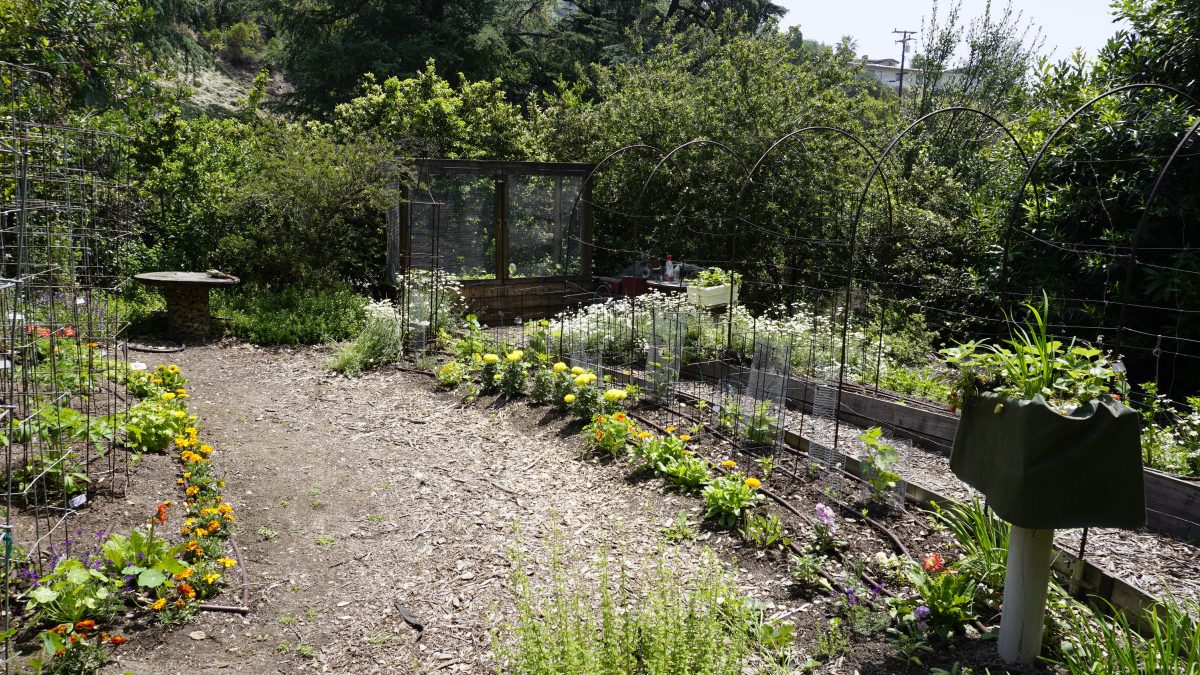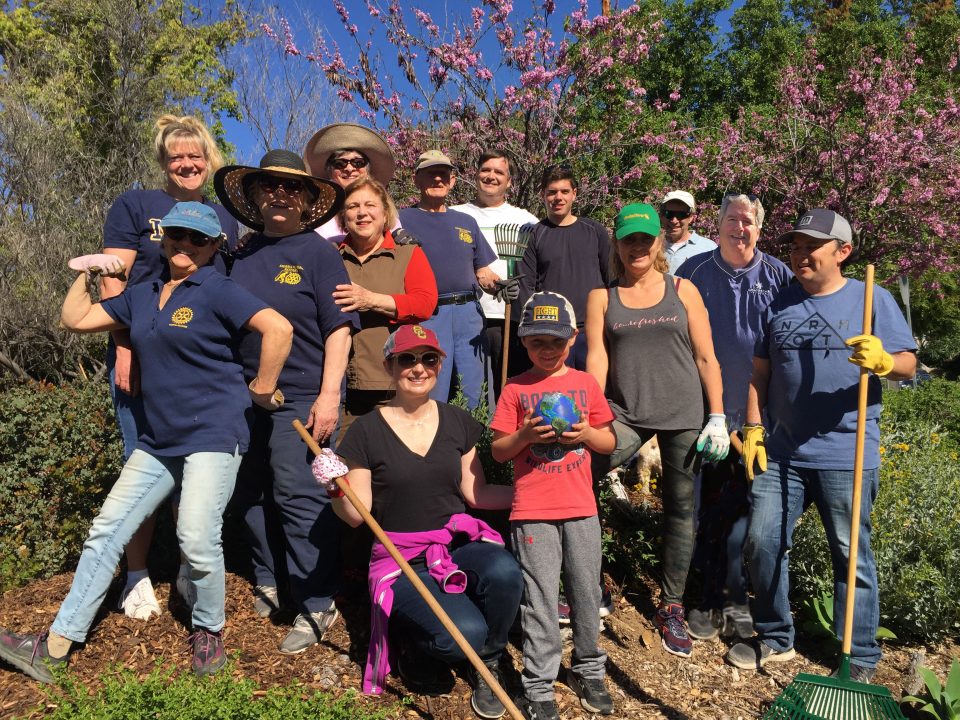- Did you receive a globe? Congratulations! Click Here for the Next Step!

Sierra Madre Rotary Club as Park Caretaker
May 10, 2019
Crafts & Snacks for the World
May 22, 2019Is it a help to the global environment to grow a vegetable garden if you have space in your home garden? I attempted to answer this question with some initial thoughts and will know more at the end of the growing season in November.
Of course, the majority of people in the world cannot grow a home vegetable garden and the role of sustainable agriculture and reduced energy transportation systems are vital for a more environmentally friendly future. For the few who have garden space and might like gardening, I hope this story is of interest.
With the help of reliable and referenced internet sources, I tried to quantify the environmental and health advantages of growing a vegetable garden in a 400 square foot area of my yard, which has full sun, good garden soil, and a drip irrigation system already installed.
I estimate that in one season cultivating my 400 square foot vegetable garden, I hope to produce 300 pounds of healthier vegetables than I can buy in the supermarket using no pesticides introduced into the environment, and no fertilizer loss into the ground water (I will carefully monitor the soil fertility and not over fertilize). I hope to be saving almost 5 pounds of global warming emissions (see calculations below) by not having to transport the vegetables from distant farms. I will get health benefits of 244 hours of exercise and stress relief. There will be very little wasted food vs as much as possibly 150 pounds of estimated food waste from conventional agriculture to supermarket system. Many supermarkets package vegetables in plastic containers or bags and I will be reducing the amount of plastic packaging that is produced and added to the landfill or hopefully would get recycled. The money saved by growing my garden vs buying produce in the supermarket hopefully will be $500. (See estimates and calculations below) which I will donate to Carry the EARTH! This sounds like a definite yes to growing a home garden.
Starting from seed in March/April:
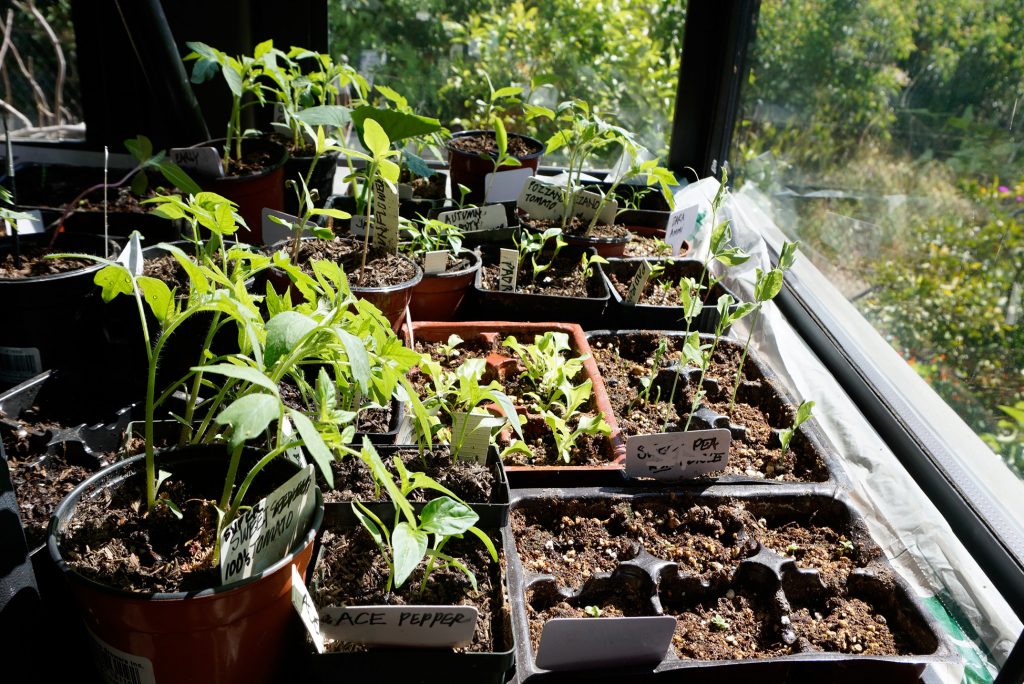
Seedlings planted into the garden in April/May:
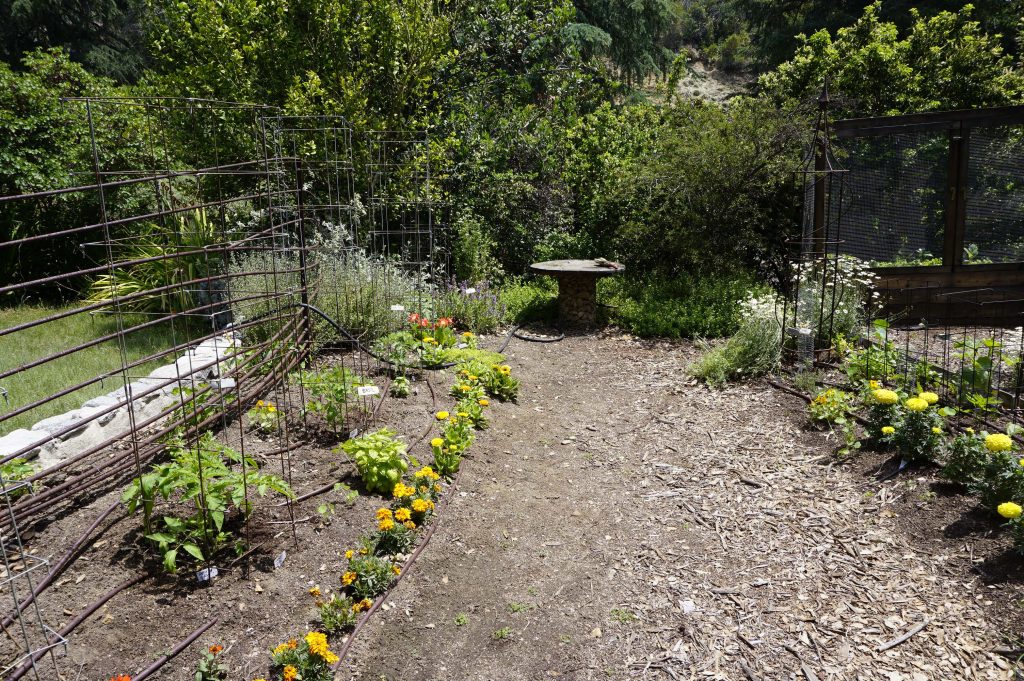
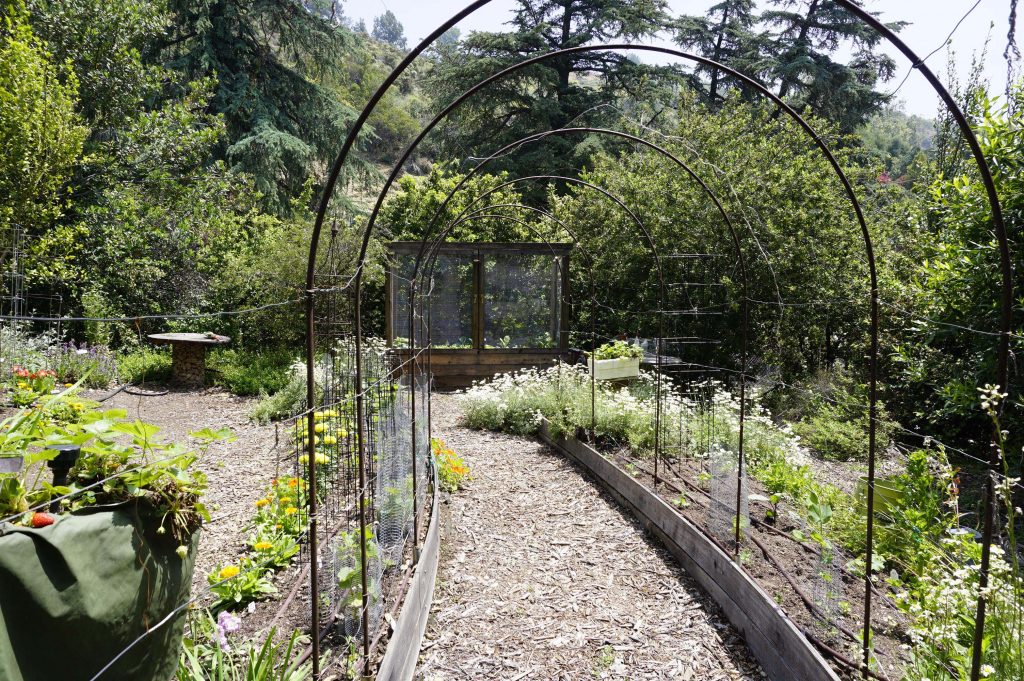
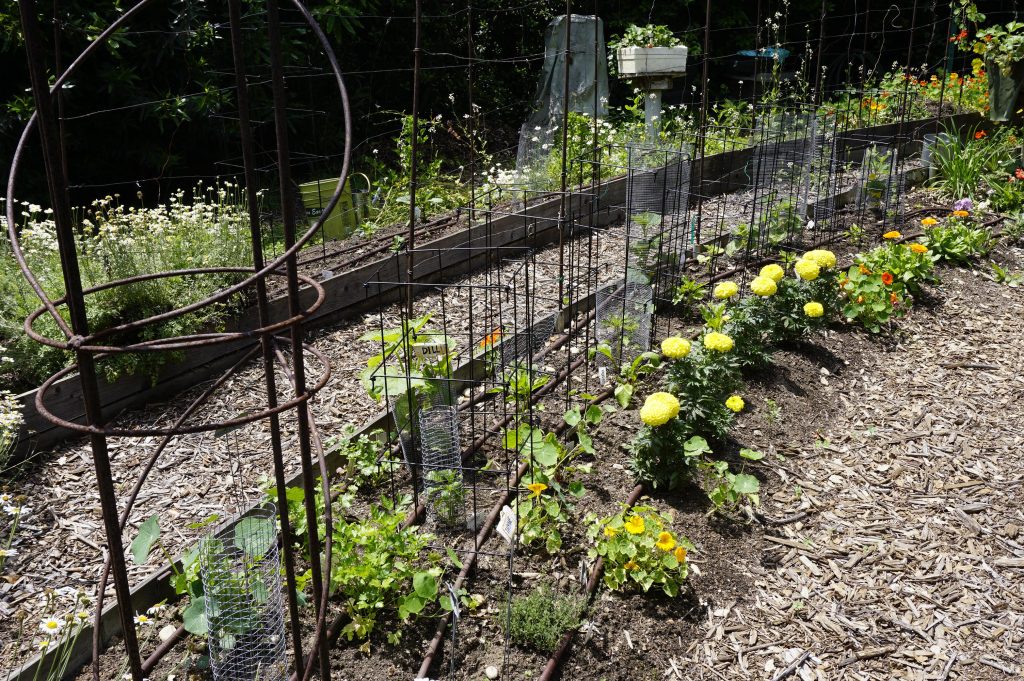
Future photos will show the development during the growing season.
In more detail, here are the calculations and the pros and cons of what I discovered:
Cons:
1-WORK: I will have to devote time gardening from March to November and the time must be exactly when work is required for optimal plant growth and harvesting. I will garden for 8 months– 244 days and predict that I will average 1 hour per day preparing soil, weeding, composting, planting and harvesting vegetables. That means that I expect to spend about 244 hours per season gardening for 400 square feet of space. My compensation will be estimated at $2.05 per hour (way below minimum wage but who gets paid for a hobby or exercise class anyway?) using the estimated costs and gains tabulated below, however, I will figure out the real cost savings of growing my own vegetables at the end of the season and my exact hourly compensation.
2- LOSS OF YARD SPACE: Lose the use of 400 sf of outdoor garden space for other purposes.
3- WATER AND ENERGY CONSUMPTION: Water consumed for growing vegetables should be the same in my garden which uses a drip system vs an equally efficient farm. (I am not sure if farms in my area are as water efficient as my drip system and if not a pro would be saving water). My garden gets water transported from great distances and is purified for drinking which uses added energy vs farms in California which may use well water right under their farm. (Some underground water supplies in agricultural areas of California are not being recharged so the pro would be reducing aquifer depletion under farms.) I used WUCHOLS (Water Use Classification of Landscape Species) formula to estimate my water use to grow vegetables in my location: https://cimis.water.ca.gov/Content/PDF/wucols00.pdf. The energy cost of water transportation and water purification from the Sierra Mountains and Colorado River according to my local water district’s estimates is approximately 25% of my $104. projected water cost or $26.00 in energy costs. I am not sure how this translates into additional CO2 into the environment but it does add something.
4- FOOD LOSS FROM LOCAL WILDLIFE: I anticipate from past experience that there will be some food loss from problems battling local wildlife for the food I grow. It won’t be wasted as it will feed the local wild animals but it won’t be feeding people. Farms may have more efficient ways of dealing with hungry critters and I am not sure if poisons are involved. I don’t plan on using pesticides or poison.
Pros:
***https://pss.uvm.edu/ppp/articles/whygrow.html
1-IMPROVED HEALTH– Having a garden will improve my health as I will be eating more vegetables if they are ripe at my doorstep. In addition, the vegetables that I grow will be picked ripe with more vitamin content than ones picked for transport and they will not have pesticide residue. The 244 hours of outdoor gardening exercise should have beneficial health effects in terms of stress reduction and physical fitness.
2- PESTICIDE FREE AND REDUCED FERTILIZER USE BENEFITS: Organic home vegetable and fruit gardens can reduce the amount of fertilizers that are needed to be produced for agriculture and eliminate need for pesticides. By composting green waste from the home garden and recycling it into natural fertilizer, energy to transport the green waste away from the home is saved as well as the energy to produce chemical fertilizers and transport them to the alternative farm. Organic farming wherever it is, helps reduce the problem of excess fertilizers getting into and polluting ground water. By using beneficial insects and avoiding pesticides there is less pollution from pesticide use and less energy costs to produce and transport pesticides. Below is some referenced material of interest.
“Another factor to take into account is the use of pesticides and synthetic fertilizers on conventionally grown crops. In the United States, the Environmental Protection Agency (EPA) approved the use of many pesticides that were not yet extensively researched and were later linked to cancer and other diseases. Now the EPA considers 60 percent of all herbicides, 90 percent of all fungicides and 30 percent of all insecticides carcinogenic. In fact, the latest EPA information on U.S. pesticide usage, from 2007, reports that over one billion tons of pesticides are used in the U.S. every year. This is 22 percent of the estimated 5.2 billion pounds of pesticides used worldwide. Agricultural use accounted for 80 percent of pesticide use in the U.S. If you are growing your own food, you can decide what goes on, or what doesn’t go on, your produce.” Quotes from: https://www.onegreenplanet.org/environment/how-growing-your-own-food-can-benefit-the-planet/
3-REDUCED FARM TRACTOR AND TRANSPORTATION FUEL ENVIRONMENTAL COSTS: My home garden will reduce energy use that normally is required by farms for tractors to cultivate the land and sometimes to pick the crop, along with the trucking of produce from the larger source farms to supermarkets.
CUESA (Center for Urban Education about Sustainable Agriculture): https://cuesa.org/learn/how-far-does-your-food-travel-get-your-plate says that
“ It is estimated that the meals in the United States travel about 1,500 miles to get from farm to plate. Why is this cause for concern? There are many reasons:
- This long-distance, large-scale transportation of food consumes large quantities of fossil fuels. It is estimated that we currently put almost 10 kcal of fossil fuel energy into our food system for every 1 kcal of energy we get as food.
- Transporting food over long distances also generates great quantities of carbon dioxide emissions. Some forms of transport are more polluting than others. Airfreight generates 50 times more CO2 than sea shipping. But sea shipping is slow, and in our increasing demand for fresh food, food is increasingly being shipped by faster—and more polluting—means.
- In order to transport food long distances, much of it is picked while still unripe and then gassed to “ripen” it after transport, or it is highly processed in factories using preservatives, irradiation, and other means to keep it stable for transport and sale. Scientists are experimenting with genetic modificationto produce longer-lasting, less perishable produce.”
In my location, farms supplying local seasonal produce are only 100-400 miles away from me so I will use that figure in my analysis. I can’t grow everything that I consume year round. For example, much of what I eat is imported from locations that are more distant and other climates such as sugar, wheat (flour), nuts, and fruits and veggies that are not in season here. All of these commodities travel much farther to get to me. I should consider living more on what I can grow; however, in my calculations of benefits in having a small garden, I will figure only the real benefits of in season produce that I can grow vs buying the equivalent in the supermarket.
Here are some facts I used in my very rough estimate of savings of CO2 emissions from having a home garden:
- This article provides some interesting information regarding the distance food travels and the environmental cost: http://large.stanford.edu/courses/2014/ph240/pope1/
- Average miles food travels from farm to table in the USA= 1500 miles.CUESA (Center for Urban Education about Sustainable Agriculture) https://cuesa.org/learn/how-far-does-your-food-travel-get-your-plate
- Average miles seasonal vegetables and fruits that I can grow in my home garden travel from farm to table in California. = only 250 miles!
- Average weight of produce carried by large trucks = 50000 lb. per truck (California Tomato Growers Association http://www.ctga.org/TomatoFacts) and Truck fuel efficiency current estimate https://www.nap.edu/read/12845/chapter/4 is 155 miles per gallon per ton of produce.
- The distance to local farms is 250 miles and would use 1.6 gallons of gas per ton of produce or for 250 miles; it would be .24 gallons of gas per my estimated expectation of 300 pounds of produce.
- Union of Concerned Scientists estimates that 24 pounds of CO2 is emitted per gallon of gas. https://www.ucsusa.org/clean-vehicles/car-emissions-and-global-warming .24 gallons= 5.76 pounds of CO2.
My 400 sf garden with average production of .75 pounds of produce per sf would equal 300 pounds of seasonal produce. If this estimate is correct, I might save 5.76 pounds of global warming emissions just for not having to transport the vegetables by trucks 250 miles and this emission total doesn’t include the farm equipment fuel use, wasted veggies, the energy to produce and transport fertilizer and pesticides, and the energy to remove my green waste.
- REDUCED FOOD WASTE: The decay and removal of wasted food causes climate change emissions and wasted energy to produce the food that doesn’t get used. Some estimates say that there is as much as 50% of grown vegetables and fruit that go to waste. https://www.theguardian.com/environment/2016/jul/13/us-food-waste-ugly-fruit-vegetables-perfect. There is more spoilage when food is picked by machine, transported further distances, and sits on the supermarket shelves until purchased. In a home garden this spoilage can be reduced to almost nothing if the gardener is diligent (which I hope to be) and produce is picked when ripe and used immediately or canned at home for use later. I plan to can or share my excess food with neighbors or homeless shelters to avoid any waste.
- ACTUAL COST SAVINGS:
EXPENDITURES:
- Water cost: 400 sf of garden space= High water use with drip system from April 1- October 31 is estimated using WUCHOLS: https://cimis.water.ca.gov/Content/PDF/wucols00.pdf at 9166 gallons or 1222 cf. 22 units x $8.56 per unit. =$ 104.70 cost for water for the 7 month growing season. $105.
- Cost of seeds= $75
- Cost of extra organic compost and organic fertilizer to supplement my composting = $100
- Cost of plants grown in a local nursery=$100.
Total expected cost= $380.00
Produce from garden in pounds and market cost per pound (to be tabulated and updated in November 2019):
Cucumbers
Lettuce
Scallion
Herbs
Padrone Peppers
Red Peppers
Heirloom Tomatoes
Zucchini
Eggplant
Beets
Bok choy
Cut Flowers
Strawberries
Celery
Arugula
Fennel
Cut Edible Flowers
Snow Peas
EXPECTED PROFITS:
Total estimated yield 300 lbs. at $3/pound (estimated average for organic herbs, fruits and vegetables in the supermarket) = $900. The estimated gain in produce of $900-$380 cost with free labor= $520.00 profit.
Actual yield and prices per pound will be tracked during the next 8 months and I will update this post in November 2019.

